Solar System - Mercury | Collision simulation [Video]
Hello everyone!
At the beginning the solar system was a whirlpool of gas and dust. Little by little the small remains of matter were joined with larger ones. After millions of years the planets were formed.
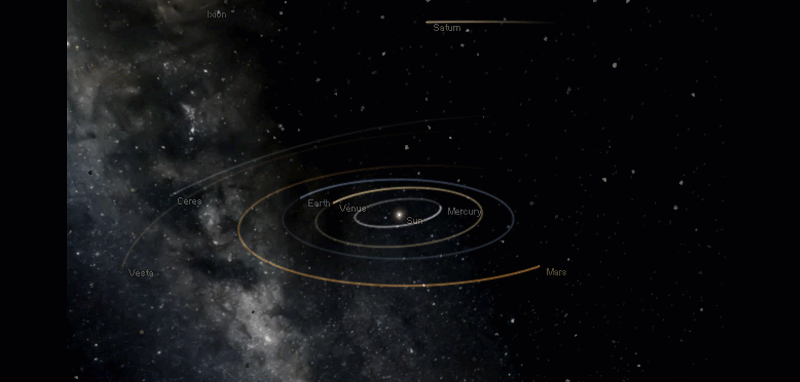
Courtesy of Universe SandBox2 - Captured by the author of this publication.
Its distance to the sun is between 46 million km and 70 million km, becoming the planet closest to the sun.

Courtesy of Universe SandBox2 - Captured by the author of this publication.
It is too small to generate a strong gravitational field, necessary to retain an atmosphere, this means that it is unprotected against the celestial bodies.
Having no atmosphere is impossible to transmit some kind of sound, for example if you are on Mercury you could not hear a volcano erupting, so there is complete silence.
Gravity depends on the mass of an object, the greater the mass the greater the gravity. Since the mercury gravity is so weak, if you weigh 68 kg on Earth, you would only weigh 25 kg in mercury.
Movement
Mercury is a dead planet that has been this way for more than 4 billion years. But to be an almost lifeless planet mercury still has some movement. Baptized by the ancient Romans, in honor of the messenger god. Mercury orbits the sun in just 82 Earth days, faster than any planet.
But when it comes to the time it takes to turn on its own axis, the planet holds the record of being the slowest. Its duration is 182 terrestrial days, almost half a year on earth. That is, one day has more days than a year. It sounds strange, right? but it is like this.
The gravitational force of the sun creates a friction within mercury that reduces its speed by turning on its axis. That means that a year on Mercury is shorter than a day on the planet.
characteristics
For 6 months, the side exposed to the sun reaches 425°C and the other side falls to -185 °C, ice can exist in craters.
It is formed by solid rock, has a core rich in iron like Earth. This nucleus is as big as the Moon. The size of Mercury is 60% smaller than that of the earth, with 4880 km it is the smallest planet of the so-called "inner planets".
In the following images we can compare its size with the Earth, the moon and our star.
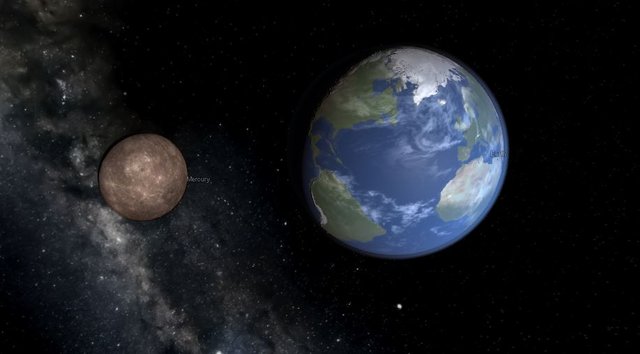
Courtesy of Universe SandBox2 - Captured by the author of this publication.
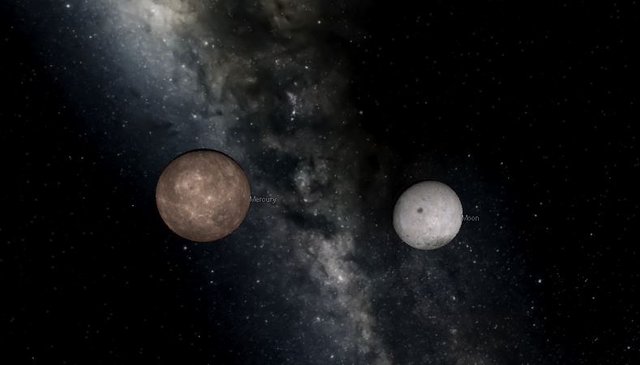
Courtesy of Universe SandBox2 - Captured by the author of this publication.
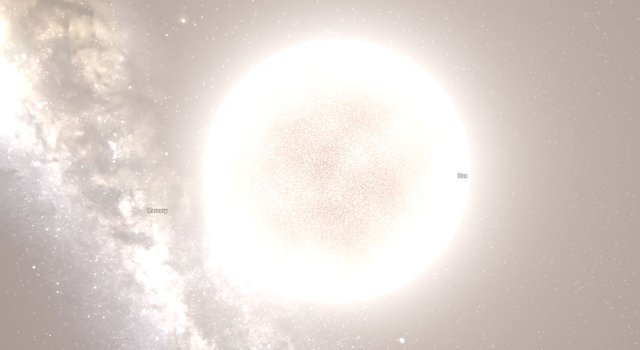
Courtesy of Universe SandBox2 - Captured by the author of this publication.
Surface
Very similar to our Moon, Mercury is full of craters. Mercury has seen millions of asteroids and meteorites explode on its surface, as it has no atmosphere to protect it. This makes mercury the planet with the most craters in the solar system.
Countless impacts of meteorites and asteroids have left scars on mercury in the form of dents and crater rings. Today the planet looks beaten, it looks like a terrestrial corpse.
Would you like to see what happens when an object hits Mercury?
We know that our Moon is a little smaller than Mercury, which would happen if an object the size of the Moon hits Mercury. What characteristics would you change?
Let's first write down some Mercury data that the Universe SandBox application gives us, before seeing the collision of these two bodies.
Are you ready for action? PLAY!
After the collision the planet changed completely from appearance, to one more aggressive and dangerous. Several physical characteristics changed, after the impact its mass increased approximately 18% and its radius 12%. The mass of the Moon merged with that of Mercury.
Its temperature obviously increased a lot, approximately 720%. The planet that seemed calm, now looks like hell. Probably that's how it looked during his training.
The Moon has a diameter of 3474 km, when hitting Mercury caused the speed of rotation to accelerate, increasing more than 700% of its speed before impact.
As we could see in the video, the shock caused the fragments detached from both bodies to shoot out through space, but they fell again. If before this planet had craters, now much more.
We met some characteristics of this "dead" planet and simulated a clash of two bodies, to compare their data before and after the impact. I hope you liked the video and this trip through Mercury.
Until a next post!
References:
- Images captured by me in the Universe Sandbox2 software.
- Planet Mercury. Autor: Brian Dunbar. NASA. 3 de agosto de 2017.
Nasa.gov - Planet Mercury - Mercury (Planet). Wikipedia. 22 may 2018.
Wikipedia.org - Mercury
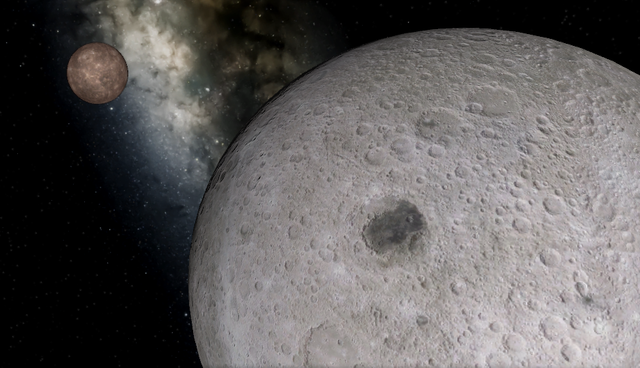
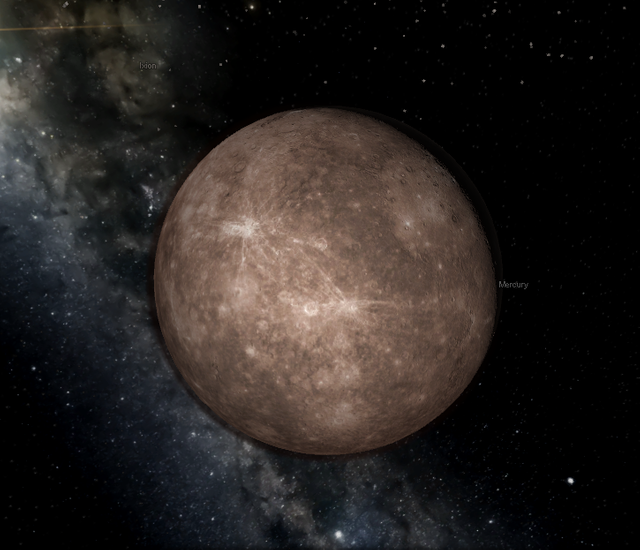

Solar System - Mercury | Collision simulation [Video] has been resteemed by the mystical @resteemmuse!!
Hi oscarcc89,
LEARN MORE: Join Curie on Discord chat and check the pinned notes (pushpin icon, upper right) for Curie Whitepaper, FAQ and most recent guidelines.
Thank you very much for the support, they are the best!
Have a nice day...
Thank you very much @oscarcc89 for this valuable information, when we are young and we are in school, most of the time we do not pay attention to this content of great value, but steemiteducation opened these possibilities so that people like you can refote the memory with learning like these, I appreciate that you have dedicated yourself to study about the mercury planet, maybe many of us did not know so many interesting features, I congratulate you. Greetings.
so he's a friend, maybe in classes they explained the characteristics of the mercury planet but I did not pay attention, I do not really remember. But as things change, I am now interested in the planets that make up our solar system. hehe
Greetings, have a nice day!
Congratulations @oscarcc89 , it's a great article. God bless you.
This is nothing more than cartoons with science fiction fairy tales. These lies about Earth are a joke that billions of people have fallen for. Wake up and realize we do not live on a spinning space rock.
Anyone can start this by calculating and representing the supposed curvature of the Earth (spoiler- there is no curve)
Just like there are none of these other ball planets that nasa shows to us in their cartoon drawings, anyone with a telescope can use it to look up at night and find that all of the stars are reflections of light that constantly change shape. Videos of star trails have shown that each and every star rotates east to west overhead in a circle and ends back up in the same exact place night after night. There are plenty of records of this in the past 2000 years of astrology and astronomy. This would simply not be possible on a spinning, wobbling, ball rocketing through infinite space at millions of miles per hour.
Wake up and figure out that you've been lied to about what you were taught in school regarding the natural and physical properties of the Earth.
This is nothing more than cartoons with science fiction fairy tales. These lies about Earth are a joke that billions of people have fallen for. Wake up and realize we do not live on a spinning space rock.
Anyone can start this by calculating and representing the supposed curvature of the Earth (spoiler- there is no curve)
Just like there are none of these other ball planets that nasa shows to us in their cartoon drawings, anyone with a telescope can use it to look up at night and find that all of the stars are reflections of light that constantly change shape. Videos of star trails have shown that each and every star rotates east to west overhead in a circle and ends back up in the same exact place night after night. There are plenty of records of this in the past 2000 years of astrology and astronomy. This would simply not be possible on a spinning, wobbling, ball rocketing through infinite space at millions of miles per hour.
Wake up and figure out that you've been lied to about what you were taught in school regarding the natural and physical properties of the Earth.